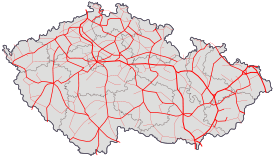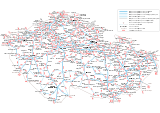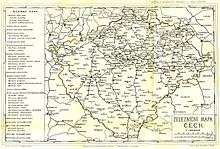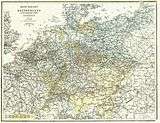Rail transport in the Czech Republic
| Czech Republic | |||||
|---|---|---|---|---|---|
|
| |||||
| Operation | |||||
| National railway | České dráhy | ||||
| Infrastructure company | Správa železniční dopravní cesty | ||||
| Major operators |
Passengers České dráhy RegioJet LEO Express Freight ČD Cargo AWT METRANS | ||||
| System length | |||||
| Total | 9,619 kilometres (5,977 mi) | ||||
| Double track | 1,830 kilometres (1,140 mi) | ||||
| Electrified | 2,997 kilometres (1,862 mi) | ||||
| High-speed | 0 kilometres (0 mi) | ||||
| Track gauge | |||||
| Main | 1,435 mm (4 ft 8 1⁄2 in) | ||||
| Features | |||||
| No. tunnels | 154 | ||||
| Tunnel length | 42.37 kilometres (26.33 mi) | ||||
| Longest tunnel |
Březenský tunel 1,758 metres (5,768 ft) | ||||
| Longest bridge |
Negrelliho viadukt 1,110 metres (3,640 ft) | ||||
| No. stations | 2808 | ||||
| Highest elevation |
Kubova Huť[1] 995 metres (3,264 ft) | ||||
| |||||
Rail transport in the Czech Republic carried 162.906 million passengers and 68.37 million tonnes of cargo in the year 2009.[2] The majority of passenger services run nowadays are operated by the state company České dráhy (Czech Railways), which until 2007 also managed cargo services now run by ČD Cargo. In 2009 the country had 9,420 km of standard gauge track, 3,153 km of which is electrified.[2] The network has same gauge links to all four countries bordering the Czech Republic (Slovakia, Austria, Germany and Poland) with passenger services to all four countries in operation. Major hubs for international passenger services on the network are in Prague, Ostrava and Břeclav,[3] and the busiest station (by number of passengers) is Praha hlavní nádraží.
History
History of rail transport in the territory of the present day Czech Republic dates back to the Austro-Hungarian empire. The first horse-drawn railway in Europe, between České Budějovice and Linz (in present-day Austria) commenced operations in 1832,[4] and the first locomotive-hauled railway from Vienna to Břeclav opened seven years later. Throughout the rest of the 19th century the rail network in the whole of Europe grew rapidly and after the First World War and the independence of Czechoslovakia, the company Československé státní dráhy (Czechoslovak state railways) was founded. From 1948 until the Velvet Revolution the border crossings with Austria and West Germany were strictly controlled. Following the fall of communism, the railway network was reopened to Western Europe; the first EuroCity trains operated in transitional Czechoslovakia in 1991. In the 21st century the network has undergone extensive modernisations, and newer rolling stock (such as the Class 680 "pendolino") have been introduced.
Operation
The company Správa železniční dopravní cesty (SŽDC) is responsible for maintaining the infrastructure. In 2010, the Czech government proposed merging SŽDC and České dráhy to a single company. In 2011, RegioJet, a subsidiary of Student Agency, became the first company to actively compete with České dráhy on a route, launching a service between Prague and Havířov.[5] Other private companies own exclusive rights to run services on certain lines.[6] The Czech Republic is a member of the International Union of Railways (IUC) and has the country code 54.
Rail links to adjacent countries
- Austria — voltage change 25 kV AC/15 kV AC
- Germany — voltage change 3 kV DC/15 kV AC
- Poland — same voltage 3 kV DC
- Slovakia — same voltage 3 kV DC (north) and 25 kV AC (south)
Modern and historical railway maps
| Maps of railways in the Czech Republic | ||||||
|---|---|---|---|---|---|---|
|
See also
- Czech rail border crossings
- History of rail transport in the Czech Republic
- Narrow gauge railways in the Czech Republic
- High-speed rail in the Czech Republic
References
- ↑ http://www.crwflags.com/fotw/flags/cz-pt.html
- 1 2 České dráhy Group, Statistical Yearbook 2009, available online on www.cd.cz
- ↑ Komarek, Jan. "Cross-city line will transform Praha". Railway Gazette International. Retrieved 13 June 2012.
- ↑ Ellington, Lucien (2004). Eastern Europe: An Introduction to the People, Land, and Culture. ABC-CLIO. p. 267. ISBN 1576078000. Retrieved 30 July 2014.
- ↑ http://ekonomika.idnes.cz/ceske-koleje-zezloutly-jancuruv-vlak-poprve-vyjel-f8u-/ekonomika.aspx?c=A110824_195055_ekonomika_abr
- ↑ http://www.railwaymarket.eu/rm2008/pdf/Passenger_Railway_Transport_in_The_Czech_Republic.pdf
External links
- Winchester, Clarence, ed. (1936), "In central Europe", Railway Wonders of the World, pp. 1454–1463 illustrated description of the railways of Czechoslovakia in the 1930s.
| Wikimedia Commons has media related to Rail transport in the Czech Republic. |



